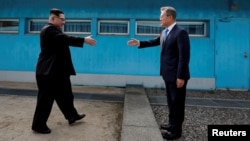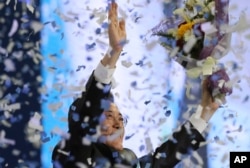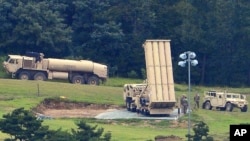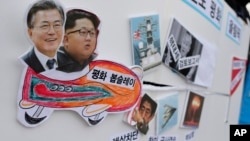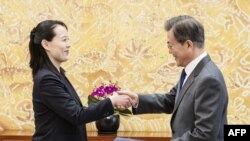During his first year in office, South Korean President Moon Jae-in’s persistent pursuit of diplomacy, often working in parallel with U.S. President Donald Trump’s “maximum pressure” campaign, played a significant role in persuading North Korea to engage in talks to end its nuclear program.
“Before the extreme measures might have been chosen by the United States, he gave diplomacy another chance to succeed,” said Bong Young-shik, a political analyst with the Yonsei University’s Institute for North Korean Studies in Seoul.
A year ago this week, Moon, a former human rights lawyer and candidate for the progressive Democratic Party, won a special presidential election held after former conservative President Park Geun-hye was impeached for her involvement in a bribery and corruption scandal. This year, Park was sentenced to 24 years in prison during criminal trial related to the scandal in which she was charged with abuse of power, coercion and bribery.
Moon assumed power at a time of increasing tensions, not just concerning North Korea’s accelerated nuclear and ballistic missile tests, but also China’s imposing of informal economic sanctions against South Korea for deploying the U.S. THAAD missile defense system, and the Trump administration’s talk of possible military action to end the North’s efforts to develop a nuclear armed intercontinental missile that could strike the U.S. mainland.
Balancing act
In his inaugural address in May 2017, Moon promised to engage in shuttle diplomacy with Washington, Beijing and Pyongyang to work out a peaceful solution to the growing crisis.
In a July speech in Berlin, President Moon laid out his vision for inter-Korean reconciliation that called for peaceful co-existence of the two Korean governments, but also said that denuclearization of the Korean Peninsula is “the absolute condition for peace.”
But unlike past progressive South Korean governments that provided unconditional economic assistance, the Moon administration complied with economic sanctions in place and offered only cooperation on humanitarian aid and exchanges. Seoul also balanced its outreach efforts with maintaining strong support for the U.S. alliance, for joint military deterrence, and for imposing increasingly harsh U.S.-led economic sanctions against North Korea.
“What we have seen so far is a fairly responsible attitude from the government here that seems to understand that there is a danger that the North Korea strategy is to drive a wedge between the United States and South Korea,” said James Steinberg, an international affairs professor at Syracuse University and a former deputy secretary of state in the Obama administration.
Rejection and appeasement
North Korea rejected the Moon administration’s early engagement efforts that included aid for children suffering from malnutrition.
In September, Trump criticized the South Korean president for continuing to try to engage the repressive government in Pyongyang. On Twitter, Trump said, “talk of appeasement with North Korea will not work, they only understand one thing!”
Moon seemed to break ranks with Trump when he spoke out strongly against taking any preventive military action against North Korea that could plunge South Korea into a catastrophic war. Trump had warned North Korea of “fire and fury like the world has never seen,” emphasizing the possible of use of American force to end the North’s nuclear threat.
Many conservatives in South Korea also criticized Moon for not unconditionally backing its U.S. ally. One South Korean newspaper called the president’s engagement policy “wishful thinking.”
Diplomacy pivot
But this year, North Korean leader Kim Jong Un moved to embrace diplomacy and accepted President Moon’s offer to participate in the Winter Olympics that were held in the South. This created diplomatic momentum that led to the recent inter-Korean summit, where Moon and Kim promised to work toward denuclearization, and the upcoming meeting between Trump and Kim to be held in the next few weeks.
The tough U.S.-led sanctions that ban most North Korean trade, along with Trump’s talk of military action, have been credited in large part with motivating Kim to change his confrontational stance. The Kim government’s own calculation that it has achieved nuclear deterrence capabilities and was now ready to shift to economic development may also be a factor.
But Moon’s proactive outreach efforts also provided the diplomatic path forward for both Kim and Trump to engage in talks.
“If the Moon administration had not emerged in South Korea, this kind of reconciliation mood would not have been made in the first place,” said Ahn Chan-il, a North Korea defector and analyst with the World Institute of North Korea Studies.
Lee Yoon-jee contributed to this report.




